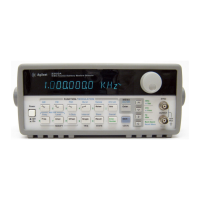If you copy to a waveform name that already exists, the previous
waveform is overwritten (no error is generated). However, you cannot
overwrite any of the five built-in waveforms.
Up to four user-defined waveforms can be stored in non-volatile
memory. If memory is full and you try to copy a new waveform to
non-volatile memory, a +781, “Not enough memory” error is
generated. Use the DATA:DEL command to delete the waveform in
VOLATILE memory or any of the four user-defined waveforms in
non-volatile memory. Use the DATA:CAT? command to list all
waveforms currently stored in volatile and non-volatile memory.
The following statement shows how to use the DATA:COPY command:
"DATA:COPY ARB_1, VOLATILE"
DATA:DELete <
arb name>
Delete the specified arbitrary waveform from memory. You can delete
the waveform in volatile memory or any of the four user-defined
waveforms in non-volatile memory.
You cannot delete the arbitrary waveform that is currently being
output. If you attempt to delete the waveform being output, a
+787, “Cannot delete an active arb waveform” error is generated.
You cannot delete any of the five built-in arbitrary waveforms. If you
attempt to delete one of the built-in waveforms, a +786, “Cannot delete a
built-in arb waveform” error is generated.
Use the DATA:DEL:ALL command to delete the waveform in VOLATILE
memory and all user-defined non-volatile waveforms all at once.
If one of the waveforms is currently being output, a +787, “Cannot
delete an active arb waveform” error is generated. The active
waveform is not deleted but all of the other waveforms are deleted.
4
Chapter 4 Remote Interface Reference
Arbitrary Waveform Commands
183

